 December 2021
In all things of nature there is something of the marvelous.
~Aristotle
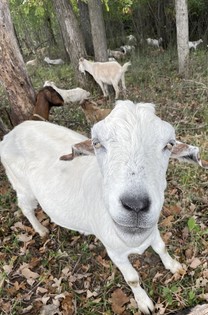
The mission of the Minnesota Department of Natural Resources (DNR) is to work with Minnesotans to conserve and manage the state's natural resources, to provide outdoor recreation opportunities, and to provide for commercial uses of natural resources in a way that creates a sustainable quality of life.
The vision of Minnesota State Parks and Trails is to create unforgettable park, trail, and water recreation experiences that inspire people to pass along the love for the outdoors to current and future generations. This includes natural resources restoration and management. When you buy your permits or anything from our Nature Stores you're supporting our conservation work. In this issue, we share just a few highlights of this work, along with some tips to do your part.
Here's to a new year with more time outdoors, caring for our land and each other. Best wishes for 2022!
|

Goat grazing is more eco-friendly than chemical treatment and more effective than pulling out the plants manually.
 Plants like European buckthorn and invasive honeysuckle bushes displace native species. Goats are great browsers and literally eat away the problem... by eating the invasive species. No one method is successful alone, so in addition to goats, staff often employ additional methods to control buckthorn and help restore a natural ecosystem.
Goats will be back at work in the spring at Afton, Flandrau and Whitewater state parks. Some Wildlife Management Areas are also using goats and cattle to improve wildlife habitat.
*GOAT: Acronym for Greatest of All Time.
Help protect the landscapes you love and prevent the spread of invasive species. Clean your gear before and after you hit the trails to remove any mud or seeds.
Lori Barrow, Wildland Firefighter with the Minnesota DNR, shares her experience assisting with wild fire at Itasca State Park.
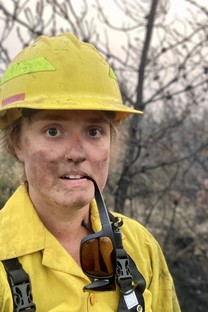
Arriving on scene and witnessing an active wildfire all around Itasca State Park’s towering red and white pines filled me with respect, awe and adrenalin. Although most folks view wildfire as destructive, it's a natural process that's critical for the health of fire-dependent plant communities such as pine.
However, when there's a wildfire, the safety of my fellow firefighters and the public is always a top priority. On this fire we utilized suppression techniques to steer the fire and reduce the potential for a larger spread. When we came back the next day to ensure the fire was cold, I marveled at how the thick bark on many of the old trees insulated them from the fire’s effects. A burned tree isn’t necessarily a wasted tree. It could provide future nesting sites for birds or homes for wildlife.
Growing up in central Illinois, I didn’t have access to a lot of open land. Only as an adult did I begin to appreciate the access to public lands we have in the United States, and all the benefits and opportunities that go with it. Natural landscapes act as a filter for the water we drink and the air we breathe, provide economic benefits, and are home to animals and plants.
When we don't protect public lands, access and benefits are negatively impacted. That's why it’s important for me to get out there, roll up my sleeves, and give back to the places that give so much to me.
|


For prairie species to thrive, we need to protect and manage their habitat. Without active management, young trees and invasive species will encroach on the area, eventually making it unsuitable for native species.
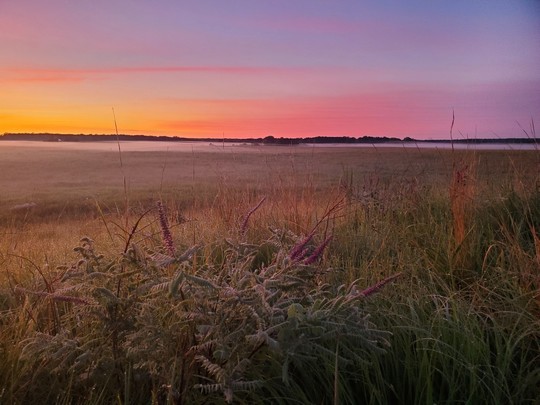 A thriving 15-year-old restoration at Glendalough State Park. Yellow prairie coneflowers bloom alongside purple and white prairie clover, and leadplant, and attract pollinators. Below, Greater Prairie-Chicken PHOTO by Dave Menke (USFWS)
Minnesota prairies are home to the largest number of species of greatest conservation need. Small white lady’s slippers, Dakota skipper butterflies and the Greater Prairie-Chicken (shown below) are just a few of the rare species that call Minnesota prairies home.

One way Minnesota State Parks and Trails helps to maintain healthy prairies is through prescribed burns. Prescribed burns help maintain and improve habitat quality for Minnesota’s rare prairie species. Some of these species are vulnerable to fire so burns are carefully planned to burn only portions of a habitat. This leaves the rest of the habitat to be used as a refuge to ensure that the species’ populations and the habitats are maintained.
Minnesota state parks have restored 5,589 acres of prairie using funds from the 2008 Clean Water and Land Legacy amendment. Come see the results at Big Stone, Blue Mounds, Camden, Glacial Lakes, Lake Bronson, Sibley and Upper Sioux Agency state parks.
|
It takes many different plants to support the life cycles of prairie pollinators. State park staff often collect seeds from prairie flowers used by bees and butterflies to plant in restorations.
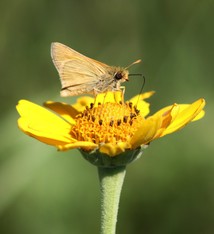
We’ve partnered with the Minnesota Zoo, the University of Minnesota, and the Nature Conservancy in Minnesota to research the decline of some of Minnesota’s prairie butterfly populations. This partnership is also exploring ways to reverse the trends and recover these threatened populations.
This continued research of rare prairie butterflies at state parks may help scientists better understand how to manage other butterfly species that are vulnerable to population declines.
Because it features large remnants of high quality prairie that once covered much of western Minnesota, Glacial Lakes State Park is home to several long-term research projects that are related to rare butterflies and their habitat preferences. Pictured, a male Dakota skipper butterfly.
Some birds are also pollinators. Like hummingbirds! Roughly 5 percent of plants that humans use for food and medicine worldwide are pollinated by birds.
|
Help Minnesota pollinators by planting native species in your yard or advocating for your city to create pollinator gardens.
Many of Minnesota’s grassland birds like meadowlarks, bobolinks and several sparrow species are declining as prairies and grasslands have been converted to other uses like cultivation, mining and development. Minnesota State Parks and Trails is restoring 300 to 400 acres of prairie annually to help provide additional habitat for these species.


In May, Minnesota said goodbye to DNR Conservation Officer Sarah Grell, who died in the line of duty following a two-vehicle crash near Grand Rapids. Grell was a devoted wife and mother, and beacon of light in her community. She served as a conservation officer since 2005 and had a deeply held dedication to serving Minnesota’s people and natural resources. She was part of a proud family legacy – her uncle, father and grandfather also worked as conservation officers.
Conservation officers have protected Minnesota’s natural resources and people since 1887. Officer Grell is the 23rd Minnesota conservation officer to die in the line of duty.
|


Cuyuna Country State Recreation Area is known for its world-class mountain biking trails. What most people don't know is that this area is also home to several species of moonwort.
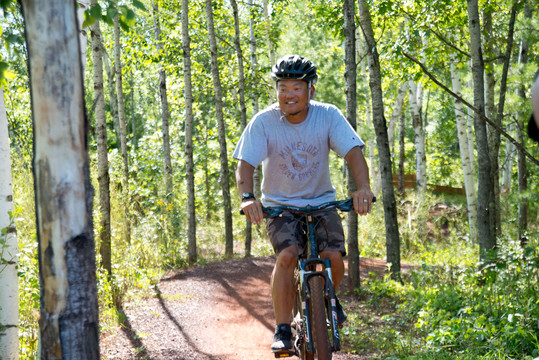 While moonworts (shown below) may live low to the ground, they’re top of mind when planning trails. Moonworts are a type of fern that are rare in Minnesota. Many are listed as of special concern, threatened or even endangered. Before trails for mountain bikers and hikers are created, botanists are brought in to survey these rare fern species. Once survey work is completed, trails are adjusted so they do not harm these tiny, often overlooked plants.
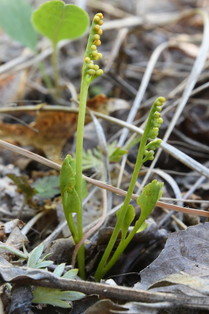
Spotted knapweed is an invasive species that has been found in Cuyuna Country State Country State Recreation Area (SRA). This plant species competes for space and resources with rare types of fern, like moonworts, found in the same area.
Rather than use herbicide to reduce the invasive species, the Minnesota DNR worked with the Minnesota Department of Agriculture to release 500 knapweed root-boring weevils (a type of beetle) in select gravel areas in Cuyuna Country SRA. The weevils lay eggs on the knapweed and the larvae burrow into the roots and destroy the invasive plants while leaving other species, like the rare moonworts, alone. Pictured, a Botrychium simplex moonwort.
|
You can help protect rare plants by staying on designated trails when enjoying parks, and always clean your gear to prevent the spread of invasive species.
Gopher snakes are listed as a special concern species in Minnesota.
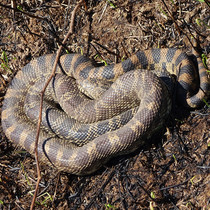
Gopher snakes are one of the largest snakes found in Minnesota. A typical adult can grow to be between three and six feet long (one to two meters). Because of its large size and behavior, the gopher snake is often mistaken for a rattlesnake. Many harmless species of snake mimic rattlesnakes by vibrating their tails to keep predators away.
If you come across a snake when enjoying the outdoors make sure to give the animal lots of space and leave it be. Remember, you’re a visitor in its home.
|
Respect the natural world. Give animals space and resist the urge to collect plants or flowers.

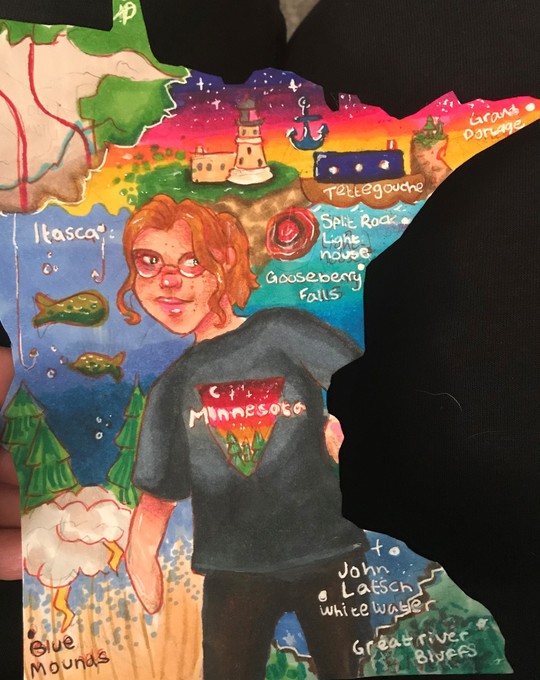 I created this map of Minnesota for 6th grade social studies to show my love of our parks.
My name is Audry Fortner and I really love to make art. I also really love state parks! I enjoy hiking, looking at cool rock formations and water features, and hunting for wildflowers. I'm a huge history fan, so I always enjoy historical features at parks. My top three parks are Tettegouche, Gooseberry Falls and Split Rock Lighthouse.
|